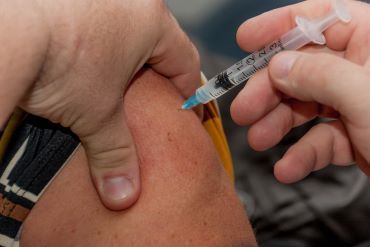From the lab to the bedside: Translating healthcare research into clinical patient benefit
The Oxford Biomedical Research Centre is helping to turn healthcare research into practical solutions to benefit patients.
 Vaccination in arm
Vaccination in armThe research undertaken at the Oxford BRC is divided into 4 Clusters (including Precision Medicine; Technology and Big Data; Immunity and Infection; and Chronic Diseases), with a total of 20 underlying Themes. Since the Centre’s establishment, the Oxford BRC has completed more than 4,600 research projects under these Clusters and Themes; produced more than 6,900 peer-reviewed publications; generated more than £1.6 billion in external funding; filed more than 600 patents; and established 27 spinout companies.
To illustrate the types of research undertaken, currently, the Oxford BRC is heavily involved in the global fight against the Covid-19 pandemic. For example:
- The Oxford BRC played a key role in the development of the world’s first approved Covid-19 vaccine, developed by the University of Oxford in collaboration with Astra Zeneca plc. The Oxford BRC provided crucial funding for the trialling of the vaccine, and subsequent funding for an evaluation of the vaccine’s safety. Prof Andrew Pollard and Prof Sarah Gilbert – both leading members of the Oxford BRC’s Vaccines Theme – were academic leads of the vaccine drive from the University’s side.
- The Oxford BRC recently supported the development of QCovid, a Covid-19 risk prediction model validated by the Office for National Statistics. Commissioned by England’s Chief Medical Officer (Prof Chris Whitty), the model helps identify those who may be most vulnerable to the virus, based on individual characteristics such as age, ethnicity, BMI, as well as certain medical conditions and treatments. The model is now helping the NHS prioritise patients with a combination of identified risk factors for the vaccine.
- Researchers at the Oxford BRC are currently involved in a national study investigating the long-term effects of lung inflammation and scarring resulting from Covid-19. The study, launched with £2 million of funding from UK Research and Innovation, aims to investigate whether post-Covid-19 lung damage will improve or worsen over time; the duration of the damage; and the best strategies for developing treatments.
Using a similar approach as applied to estimating the economic impact associated with the University of Oxford’s research activities, it was possible to assess the (net) direct and spillover impacts associated with the research undertaken by the Oxford BRC. Based on information provided by the Centre, the analysis focuses on the 2019-20 academic year.
Specifically, to assess the direct economic impact associated with the Oxford BRC’s research, we made use of information on a total of approximately £221 million of external funding received by the Centre in 2019-20. This includes £23 million of funding from the NIHR, £37 million from the UK Research Councils, £53 million from charities, £43 million from other non-commercial sources, and £64 million from industry contracts and collaborations. Compared to the £23 million in funding received from the NIHR itself, this represents a leverage ratio of 8.5 : 1.
To arrive at the net direct impact of the Oxford BRC’s research activities on the UK economy, we again deducted any public purse funding provided to the Centre, including the funding provided by the NIHR (£23 million) and the UK Research Councils (£37 million). Deducting these total public purse costs (£61 million) from the total external funding received (£221 million), the net direct impact of the Oxford BRC’s research activities in 2019-20 was thus estimated at £160 million.
Again, these research activities are expected to generate positive productivity and knowledge spillovers throughout the economy, estimated by applying the relevant productivity spillovers from the existing literature to the different types of external funding received by the Oxford BRC. As for the impact of the research of the University of Oxford as a whole, we assigned the multiplier of 12.7 to the Oxford BRC’s funding received from the UK Research Councils and charities, and the multiplier of 0.2 to all other funding received by the Centre. Using this approach, we thus estimate that the research conducted by the Oxford BRC in 2019-20 resulted in total productivity spillovers of approximately £1.177 billion. This implies a weighted average spillover multiplier associated with the Oxford BRC’s research of approximately 5.33 – i.e. every £1 invested in the Centre’s research generates an additional annual output of £5.33 across the UK economy.
Combining these (net) direct and productivity spillover impacts, the total economic impact associated with the Oxford BRC’s research in 2019-20 was estimated at £1.337.
Funders: NIHR, UK Research Councils